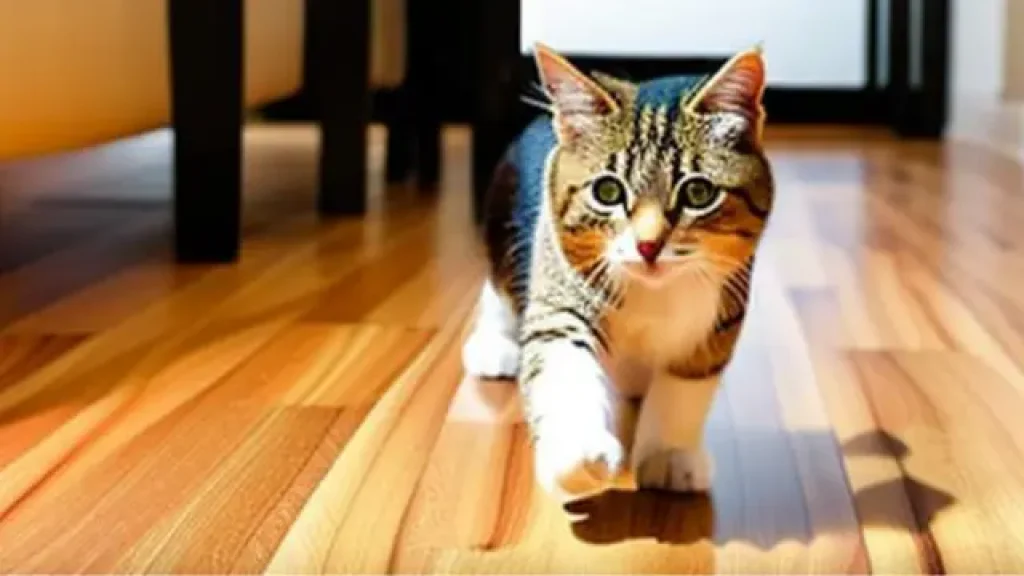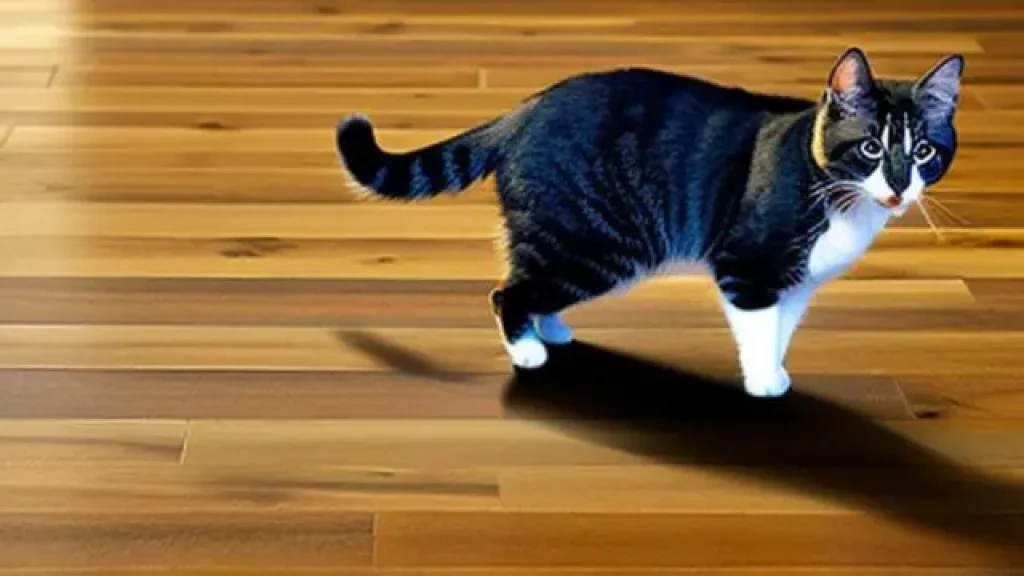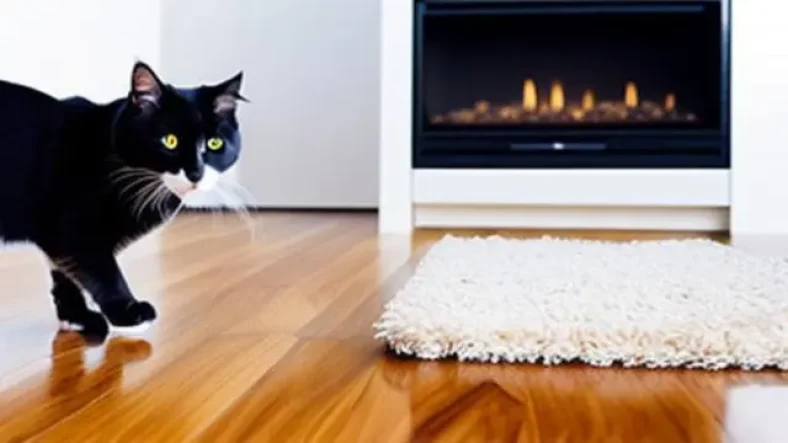Have you ever tried to figure out why your cat keeps peeing on your laminate floor, only to be met with more and more frustration?
It’s an annoying habit that can cost a lot of money and time to fix. But don’t worry – help is here!
In this article, I’m going to show you how to stop your feline friend from peeing on your floors so you can keep your home clean and clutter-free.
The good news is there are lots of things you can do to put an end to this issue.
From making changes in the environment around them, such as placing litter trays or scratching posts in different areas, to introducing calming scents into their space, these simple tips will have a huge impact on reducing urine marking behavior in cats.
We’ll also look at some common mistakes people make when dealing with this problem which could prolong it unnecessarily.
So if you’re ready to get started, let’s dive right in and see what we can do about getting rid of those pesky little puddles!
Contents
Understanding The Problem
There are two main reasons behind cats peeing outside of their litter box: behavioral problems or medical issues.
Behavioral problems can stem from stress factors such as changes in routine or environment, feeling threatened by other pets or people, not enough stimulation (like toys) in their life, and more.
Medical issues could include urinary tract infections, kidney disease, diabetes, and more. Your vet will be able to give you an accurate diagnosis if any of these conditions may be at play.
It’s important to understand what is causing the issue before making any decisions about how to solve it.
Identifying the cause will allow you to take steps toward helping your cat stop peeing on the laminate floor for good.
Identifying The Causes

Now that we understand the problem of your cat peeing on laminated floors let’s identify some potential causes. Urine marking is a common behavior in cats, and understanding why it happens can help you find ways to stop it from occurring.
Here are four key things to consider when trying to identify the cause of your cat’s urine marking:
- Medical issues such as UTI or kidney disease may lead to increased urination and thus increase the likelihood of urine marking.
- Stressful environments can trigger reactions such as spraying, which could be caused by anything from moving house, changes in routine, or even new pets being introduced into the home.
- Marketing territory is another possible reason for urine marking; cats have unique scents and will often mark their territories with small amounts of urine to make sure other cats know who lives there.
- Anxiety or fear might also trigger this type of behavior. Cats are territorial creatures, and if they feel threatened by someone else entering their space, they might start spraying out of fear.
Once you have identified any potential underlying causes for your cat peeing on the laminated floor, you can begin making changes to your cat’s environment so that it feels more secure and safe.
Making Changes To Your Cat’s Environment
As the saying goes, “prevention is better than cure,” so it is best to take preventive measures and cat-proof your home before any mess can be made.
The first step is to find a suitable place for the litter box, away from areas where your cat usually urinates.
Ensure that there are no unpleasant smells in the area since cats don’t like them either.
Also, provide some scratching posts or carpeted mats near the litter boxes so that your cat doesn’t scratch on laminated flooring as an alternative.
Finally, make sure you have plenty of cozy bedding items around for your cat to snuggle up and relax in.
By making these changes to their environment, you will help reduce or even eliminate unwanted behaviors such as peeing on laminated floors.
Next, we’ll look at training and behavioral modifications, which may also help with this issue.
Training And Behavioral Modifications
When it comes to stopping your cat from peeing on a laminated floor, training, and behavioral modifications can be effective.
Here are some ways you can work with your pet:
- Provide positive reinforcement when they go in the litter box instead of on the floor.
- Make sure there is a clean, easily accessible litter box located somewhere convenient for them.
- Ensure that their feeding schedule is consistent and they have access to plenty of fresh drinking water throughout the day.
It’s also important to understand why your cat may be going outside its designated area so as to prevent further accidents or messes.
Common causes include anxiety or stress due to changes within the environment or an uncomfortable change in routine; other cats entering their territory; unfamiliar people coming into the home; or simply not enough space for them to explore and roam freely.
Once these underlying factors are identified, steps can then be taken to rectify them accordingly if necessary.
By taking proactive measures such as providing more mental stimulation through interactive play sessions, making regular visits to their veterinarian for checkups, and maintaining consistency with their daily routines, owners can help reduce any instances of inappropriate urination behavior occurring inside their homes.
With patience, dedication, and perseverance, such behaviors can certainly be altered over time!
Remedies For Disinfecting And Deodorizing

The first step in dealing with cat pee on a laminated floor is to remove the urine. The best way to do this is by using a combination of cleaning products, such as an enzymatic cleaner and a multi-surface cleaner.
These products can help break down proteins found in cat pee, making it easier to clean up. After you’ve removed the urine, you’ll need to disinfect and deodorize the area.
One effective remedy for eliminating cat pee odor is white vinegar mixed with water.
This solution works great at killing bacteria that cause bad odors while also neutralizing any remaining smells from your pet’s accident.
Another option is baking soda and peroxide; it not only helps remove the stubborn smell but also removes any lingering stains caused by the urine.
Finally, there are special odor removers made specifically for pet messes – these work well at getting rid of tough odors without creating harsh fumes or leaving behind strong scents.
Once you have used one of these solutions to disinfect and deodorize your floors, it’s important to take preventative measures to ensure that your cats don’t keep returning to the same spot.
Seeking professional help may be necessary if the problem persists.
Seeking Professional Help
The problem of a cat peeing on a laminated floor can be quite frustrating and heartbreaking. It’s like an invisible wall separating you from your beloved pet – one that cannot be crossed by even the strongest bond between human and animal.
But there is hope! Seeking professional help from a qualified cat behaviorist may help to stop your cat from urinating in unwanted places.
Here are five tips for seeking professional help:
- Identify what type of behavior modification will work best for your cat’s unique situation, such as changing their diet or providing more stimulation during playtime;
- Consult with a certified feline behavior specialist who can provide advice tailored to your specific needs;
- Make sure the vet has experience treating cats with similar issues, so they can offer solutions that are proven to work;
- Work closely with the vet to develop an action plan and set reasonable goals based on the individual needs of both you and your cat;
- Follow through with any recommended changes in order to ensure success in resolving the issue.
It may take some time before seeing results, but if done correctly, it can result in long-term positive change. With patience and dedication, you’ll soon find yourself living harmoniously alongside your furry friend again!
Frequently Asked Questions
Q: Can spraying be considered the same as urinating?
A: To put it plainly, no, spraying is not the same as peeing. Cats will “spray” to indicate their territory by urinating on vertical objects like walls or furniture. Cats urinate when they urinate in huge quantities on flat surfaces like the floor or a bed.
Q: How do I know if my cat is experiencing a medical issue or behavioral problem?
A: Take them to the vet if you notice they are losing their appetite, acting lethargic, or urinating in inappropriate places. Once you’ve gotten the green light, you can begin investigating any lingering behavioral concerns.
Q: What should I do if my cat continues to pee on the floor even after trying all the recommended solutions?
A: If your cat continues to pee on the floor even after trying all the recommended solutions, it may be time to seek professional help from a veterinarian or cat behaviorist. They can help determine if there are any underlying medical issues or behavioral problems that need to be addressed and provide personalized solutions for your cat’s specific needs.
Conclusion
As a pet parent, it can be incredibly frustrating to come home and find that your cat has been peeing on the laminated floor. But don’t worry – with some patience and determination, you can definitely get this situation under control!
The first step is to make sure you have the right cleaning products for your particular type of flooring – those designed specifically for laminate are the safest.
After that, consider ways to prevent your cat from peeing in the same spot again, such as using a litter box or placing a physical barrier over the area. If all else fails, there could be an underlying medical cause behind your cat’s behavior, so speaking with a vet may be in order too.
By taking steps now to stop your cat from peeing on laminated floors before it becomes a problem, you’ll save yourself time and energy down the road.
As the old adage goes, ‘An ounce of prevention is worth a pound of cure.’ So take action today and start working towards solving this issue before it gets out of hand – both for your sanity and for the well-being of your furry friend!


